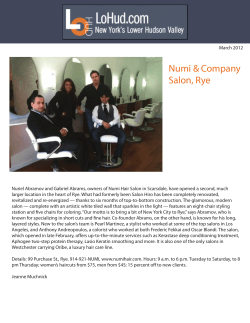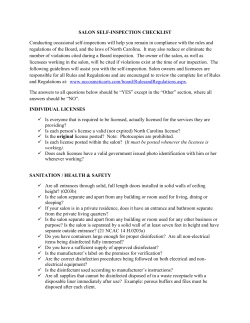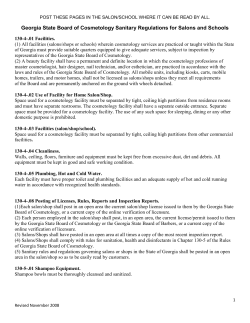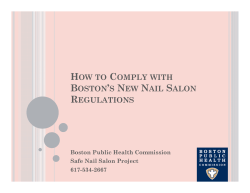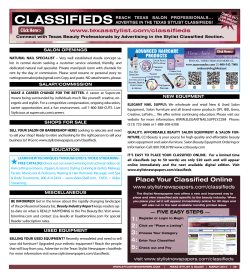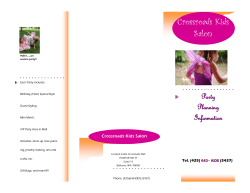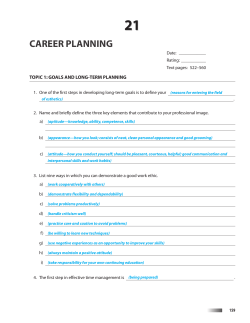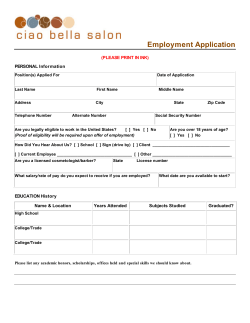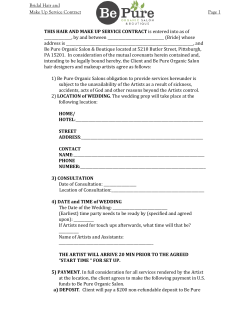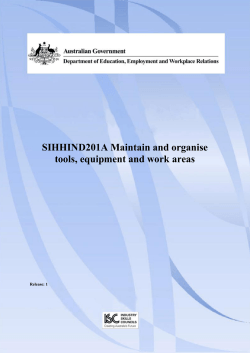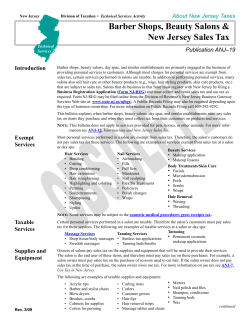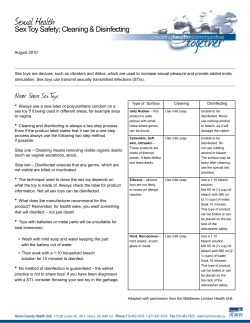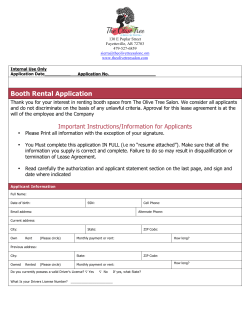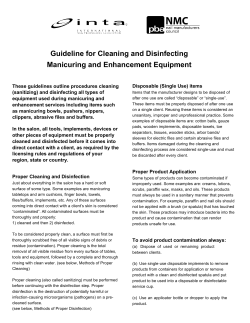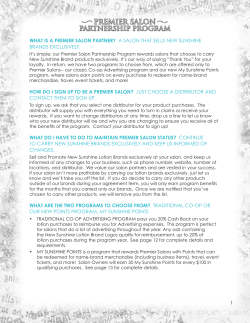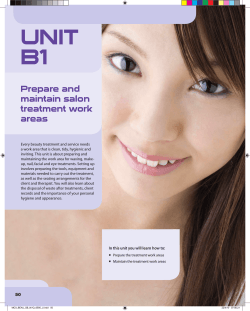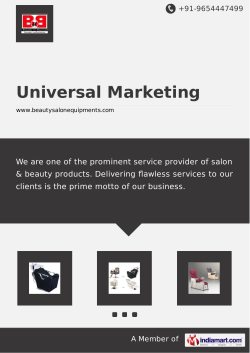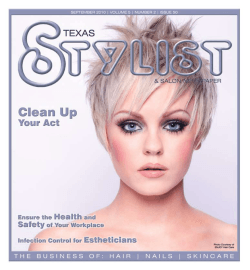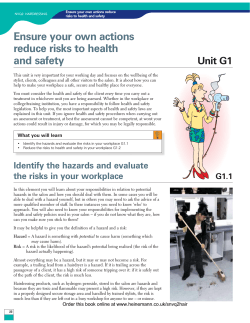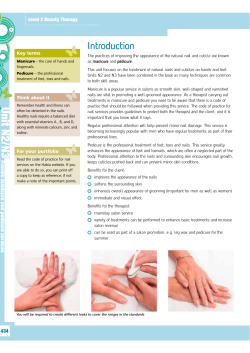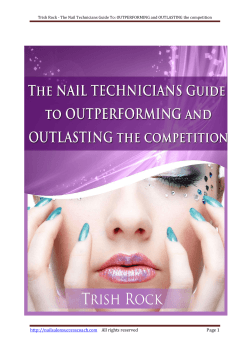
salon safety guidelines for nail technicians
BB07p064-075.qxp 11/1/06 4:54 PM Page 64 salon safety guidelines for nail technicians Editor’s note: The Nail Manufacturers Council (now a part of riety of other resources, we have compiled these Safety Guide- the Professional Beauty Association) developed sanitation guide- lines into one document. lines for nail professionals 10 years ago. Over the years, the salon It’s important to be aware that each state has its own regula- industry and the standards have changed, so we update these tions covering these areas. It’s your legal responsibility to read, guidelines every year. We thank NMC co-chairs Doug Schoon understand, and follow all of your state’s rules and regulations, and Eric Schwartz for their review and input on these guidelines. and keep up with any changes. Also, follow your product From their recommendations, the original guidelines, and a va- manufacturers’ instructions for all products used in salons. BASIC SALON SANITATION 1. Nail technicians should always clean both their hands and their clients’ hands or feet before every service. Some states allow the use of waterless hand sanitizers, but if hands are dirty or contaminated, they should be washed with liquid soap and running water first. Cleaning hands reduces the risk of spreading germs from client to client. salon safety guidelines 2. All implements (including individual implements that a client brings in or that are left in the salon), equipment, and materials that come in contact with a client must be properly cleaned (sanitized) and disinfected prior to servicing each client. Before any tool or file can be used on a client, it must be properly cleaned and disinfected. 3. If any metal tool or hard piece of equipment has come into contact with blood, body fluid, infection, or an unhealthy condition, it must immediately be cleaned and disinfected (rather than continuing to use it on the same client). If a nail file or other porous item [See sidebar on porous and non-porous items.] comes into contact with blood, it must be disposed of immediately. (There may be local, state, or federal regulations regarding items that come into contact with blood.) 4. Store clean and disinfected tools in a clean container or lined drawer (labeled “disinfected”) that is separate from soiled or used tools and files (so you never get confused and pick up a dirty implement). 5. There are very detailed guidelines related to the cleaning and upkeep of foot spas [See page 72, “Best Practices for Cleaning and Disinfecting Pedicure Equipment.”] In addition to the disinfection protocol, you should keep records of the cleaning and disinfecting of foot spas. 6. Sanitation is an often-misunderstood term. Sanitizing means “cleaning to remove all visible residue or debris.” Proper cleaning is the first step in safety, but it must be followed by disinfection, which involves describes the use of chemicals to destroy germs on non-living surfaces. Salon disinfectants include EPA-registered, hospital-level, liquid disinfectant products that are virucidal, bactericidal, and fungicidal; that are 10% bleach; or that are 70% or higher isopropyl or ethyl alcohol. 7. Use clean towels and/or manicure mats for each client. 8. Products such as creams, lotions, scrubs, paraffin wax, masks, and oils must always be used in a sanitary manner that prevents contamination. For example, paraffin and nail oils should not be applied with a brush (or spatula) that has touched the skin. To avoid product contamination: • dispose of used or remaining product between clients. • use single-use disposable implements to remove products from containers for application or remove product with a clean, disinfected spatula and put product into a disposable or disinfectable service cup. • use an applicator bottle or dropper to apply the product. 9. If blood or body fluid comes in contact with any salon surface, the nail professional should put on protective, disposable gloves and clean it with an EPA-registered, hospital liquid disinfectant or a 10% bleach solution. In case of an accidental cut, clean with an antiseptic and bandage the cut. Find more detailed sanitation instructions 64 NAILS 2006-2007 THE BIG BOOK ONLINE: The latest release from the INTA and NMC, “Recommended Best Practices — Cleaning and Disinfecting Manicuring and Enhancement Equipment” can be found at www.nailsmag.com. Click on RESOURCES, then HANDOUTS. ➤ BB07p064-075.qxp 11/1/06 4:55 PM Page 68 PRODUCT SAFETY 1. Read and follow manufacturers’ instructions for products used in the salon. Labels include information about how to use the product safely, expiration dates, safety precautions to be followed in case of a spill or reaction, and proper disposal. Also, be sure to follow local, state, and federal regulations for chemical disposal. 2. Have a Material Safety Data Sheet (MSDS) on file in your salon for every product used in the salon that could cause injury or harm. MSDS include important information about reactions, spills, ingredients, and disposal of chemicals. Make certain that the information on the MSDS is read and understood by all salon workers. Most states require MSDS to be available upon request by an inspector, and a fine might be levied for salons that don’t have them, so keep MSDS for all of your products in an easily accessible location. Many manufacturers have MSDS on their websites that can be easily downloaded. 3. Proper ventilation in nail salons is essential for client and worker safety and comfort. Make certain that your ventilation system provides fresh air intake as well as exhaustion of stale air. Air control in the salon reduces your exposure to airborne particles and bacteria as well as reduces your inhalation of product vapors, creating a healthier work environment. 4. Use a ventilation system that directs airborne debris (like filing dust) away from the breathing zone (the two foot square area between your mouth and nose and your work area) of you and your client. A mask can also be worn for further protection. 5. Use a metal trashcan with a lid (a self-closing trashcan is ideal) to reduce vapors from soiled material getting into the salon. This also reduces odor. 6. Smoking should never be permitted in a nail salon, nor should lighted candles be used anywhere nail products are used. salon safety guidelines Store all nail care chemicals in closed containers, always from any sources of heat or ignition. To Dispose or Not? There are two kinds of tools commonly used in the nail • Towels, chamois, buffing bits, and similar items can be salon: non-porous (which can be disinfected and are cleaned in a washing machine with regular detergent at the generally reuseable) and porous (which are either one-use end of each day. only [disposable] items or require specific cleaning protocol). Non-porous items are made of hard materials like metal, Know what each implement you use is, as it directly affects plastic, or glass, and include nippers, scissors, combs, metal your ability to comply with state laws and keep clients safe. or fiberglass-backed files, and drill bits. Porous items are made of cloth, wood, or other absorbent • All non-porous tools can be (and must be) disinfected materials. Porous items include most nail files, orangewood even if they do not contact blood or unhealthy conditions. sticks, cotton, paper mats, towels, and buffer blocks. These are all multi-use items. Porous items that are damaged or destroyed by cleaning • To clean a non-porous item, clean all visible debris then or disinfection procedures are single-use items (disposable) completely immerse the tool for 10 minutes in an EPA- and must be thrown away after one use. registered disinfectant, bleach solution (1 part bleach to 9 • Porous items of any type (including those that say they parts water), or 70% or higher isopropyl or ethyl alcohol. can be disinfected) that are contaminated by blood, body Other items that are not designed to touch skin, and are fluid, broken skin (skin that is not intact), infections, or used in waterless products such as nail polish, acrylic unhealthy conditions must be thrown in the trash. monomer and powder, or light-cured gels, do not spread • Porous items used on healthy nails can be cleaned by germs and do not need to be disinfected. Brushes that are manually brushing and removing all visible debris after used to remove debris from a foot spa, tub, or basin must each use, then disinfected by immersing in 70% or higher be properly cleaned and disinfected between each use. isopropyl or ethyl alcohol or 10% bleach solution. (Some If you are not sure that a file or tool can be safely cleaned, states permit spraying provided the surface is kept wet for disinfected, and used again, throw it out. Don’t risk your one to five minutes.) business or your clients’ safety to save a few pennies. 68 NAILS 2006-2007 THE BIG BOOK ➤ BB07p064-075.qxp 11/1/06 4:56 PM Page 70 PROFESSIONALISM 1. Recommend that clients seek medical advice if they have any questionable nail conditions. Never be intimidated by a client who wants a service done against your professional recommendation. It’s helpful if you have a professional referring relationship with a local dermatologist, internist, and podiatrist. 2. Inform your clients of their responsibility for proper nail care between salon visits. [NAILS Magazine’s website has Client Handouts that can be downloaded and shared with clients. The topics range from how to care for their acrylic nails to how to deal with aging skin.] 3. Observe proper hygiene and grooming yourself, and maintain a professional attitude at all times. 4. Strive to obtain a minimum of 15 hours of continuing education annually from manufacturers and/or generic industry sources, regardless of whether it’s required in your state. What Nail Techs Need to Know About Disinfectants and Detergent Cleaners salon safety guidelines You don’t have to be a scientist to stay compliant on salon sanitation (although it seems like it). This is a simplified guideline for understanding the product claims and terms used with salon disinfectant products. 1) Any EPA-registered liquid disinfectants used in the salon must have these qualities: • must have the words “bactericidal, fungicidal, and virucidal” and “hospital” on the label. • must be mixed, used, stored, and disposed of according to manufacturer’s label instructions. (It is against federal law to use an EPA-registered disinfectant contrary to its label.) • must be prepared fresh every day and replaced immediately when the solution becomes visibly contaminated. • are ineffective when proper cleaning is not performed before use. equipment in the salon. 2) EPA-registered hospital “one-step” cleaner/disinfectants may be used for disinfecting pedicure equipment if: • they are EPA-registered, hospital, bactericidal, fungicidal, and virucidal and have the words “one-step” on the label. • tools and equipment are first cleaned of large amounts of residue. • are used exactly as described by the manufacturer’s instructions. 3) All bottles and containers (other than the original manufacturer’s container) containing any disinfectant must be properly labeled, listing the contents, percentage solution (concentration), and date of mixing. 4) Chelating surfactant detergents (this is a type of cleaner recommended for pedicure spa units) break down residue from pedicure products and are effective in hard water. Hard • require complete immersion in the correct amount of water contains calcium and magnesium ions, which can disinfectant for 10 minutes after cleaning of all visible inactivate disinfectants and create residue films that are residue. Complete immersion means enough liquid to difficult for ordinary detergents to remove. cover all surfaces of the item. Note: If the disinfectant 5) You must record the time of each cleaning procedure manufacturer’s label requires a different immersion time in the salon pedicure cleaning log. Keep a log available to for soaking, you should always follow the label’s show clients. It demonstrates that you regularly clean and instructions. disinfect your pedicure equipment to ensure the customer • spray disinfectants are for cleaning surfaces only and are not adequate for disinfecting tools and pedicure is protected. Read and follow the instructions provided with the pedicure equipment to ensure proper use. NEXT: Best Practices for Cleaning and Disinfecting Pedicure Equipment 70 NAILS 2006-2007 THE BIG BOOK
© Copyright 2025
